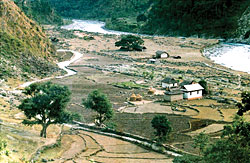 |
 PICS: DAMBAR K SHRESTHA BEFORE AND AFTER: By the banks of the Tama Kosi, Kirne today wears more propserous look than it did before the project started 15 years ago.  |
Today, Kirne is surrounded by lush irrigated paddy terraces, its twinkling CFL lights can be seen from right up the valley. There is no load-shedding, there is cable television, internet and the village has the district's best school and a hospital that even the poorest can afford.
Looking at Kirne's success story, there seems to be no reason why it can't be replicated nationwide. This tiny village has also shown us what works: investment in hydropower infrastructure to create jobs through public-private partnership and ploughing back some of the profits for community development.
"Our world changed completely with the road and electricity," says Narayandhoj Khadka, the former chairman of Sahare VDC, "our boys and girls became literate, our incomes jumped."
All this has been made possible because local community development was integrated into the design of the $140.2 million Khimti hydropower project which started selling 60MW of electricity to the national grid nearly ten years ago. The project has now become a model for future private investors in hydropower in Nepal. Khimti is the largest private hydropower project in the country and is run by Himal Power Ltd and owned by Nowray SN Power, Butwal Power Company, BKK, Alstom and GE Energy.
The uninterrupted power supply has set off a cascade of downstream industries, generating jobs. Five hundred local dairy farmers have set up a milk chilling plant with 3,000 litre capacity, others have put up poultry farms, bakeries powered by electric ovens, and even a furniture factory.
One of the most dramatic changes has been in the irrigation of formerly rain-fed farms along the Khimti and Tama Kosi valleys. This has made the region of Dolakaha and Ramechhap not just self-sufficient but also able to grow surplus food.
In Sahare, for instance, 105 households have benefited from a two km irrigation canal from a nearby stream. Farmer Keshab Bahadur KC says 60 per cent of the land in Gagantar used to lie fallow in the dry season. "Fields that used to be suitable only for maize and millet now have two rice crops a year," says KC.
Tom Solberg is the Norwegian manager of Himal Power and says: "Our cooperative model is an example of how a hydropower investor can work for local development." Himal Power says it hopes to adopt the same model when its partners develop the Tamakosi 2 and 3 projects upstream.
Previous Company of the month:
November 2007
December 2007
January 2008
February 2008
March 2008
April 2008
May 2008
July 2008
April 2009
May 2009
June 2009
July 2009
READ ALSO:
The power of a good example - FROM ISSUE #464 (07 AUG 2009 - 20 AUG 2009)


